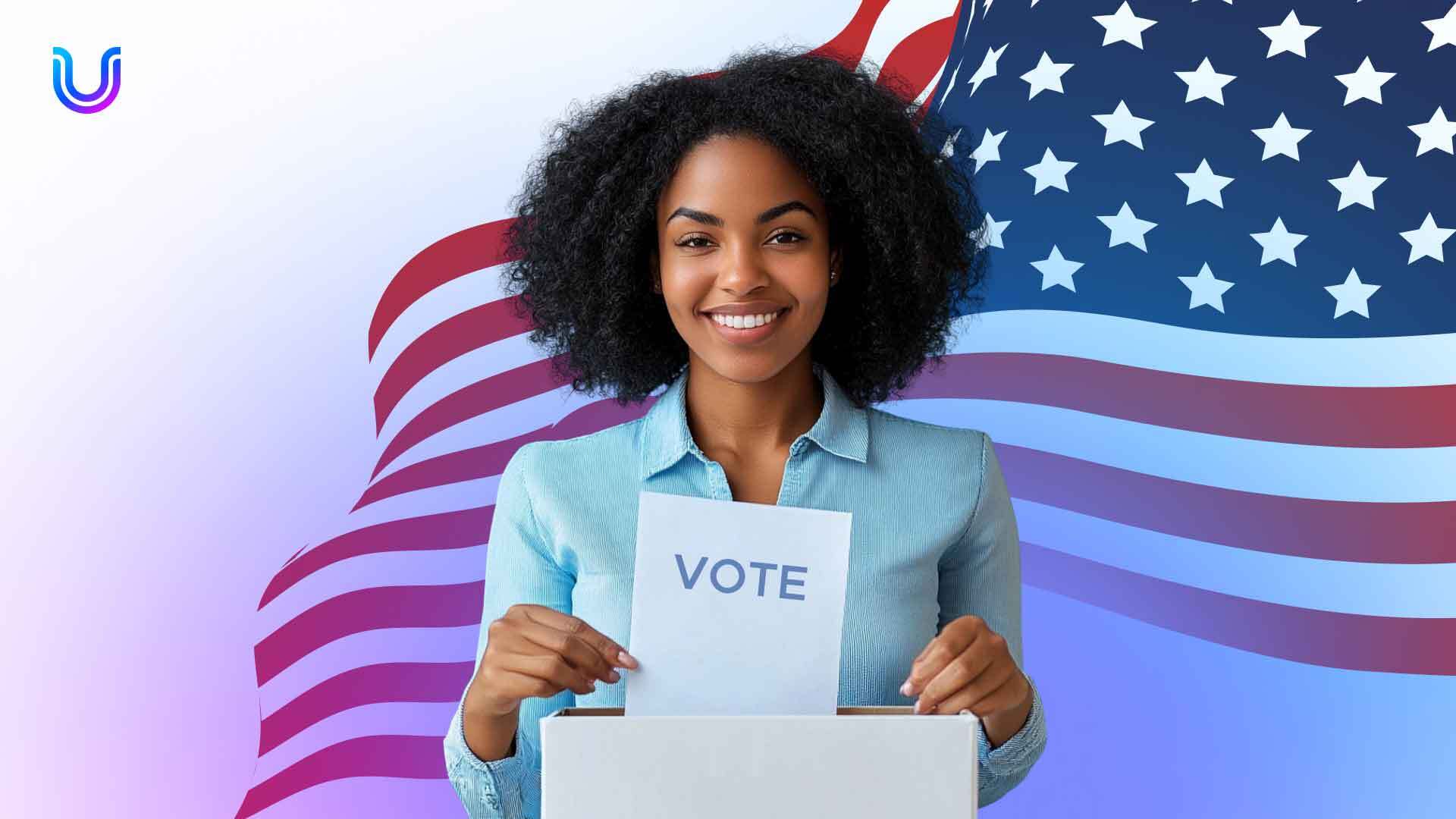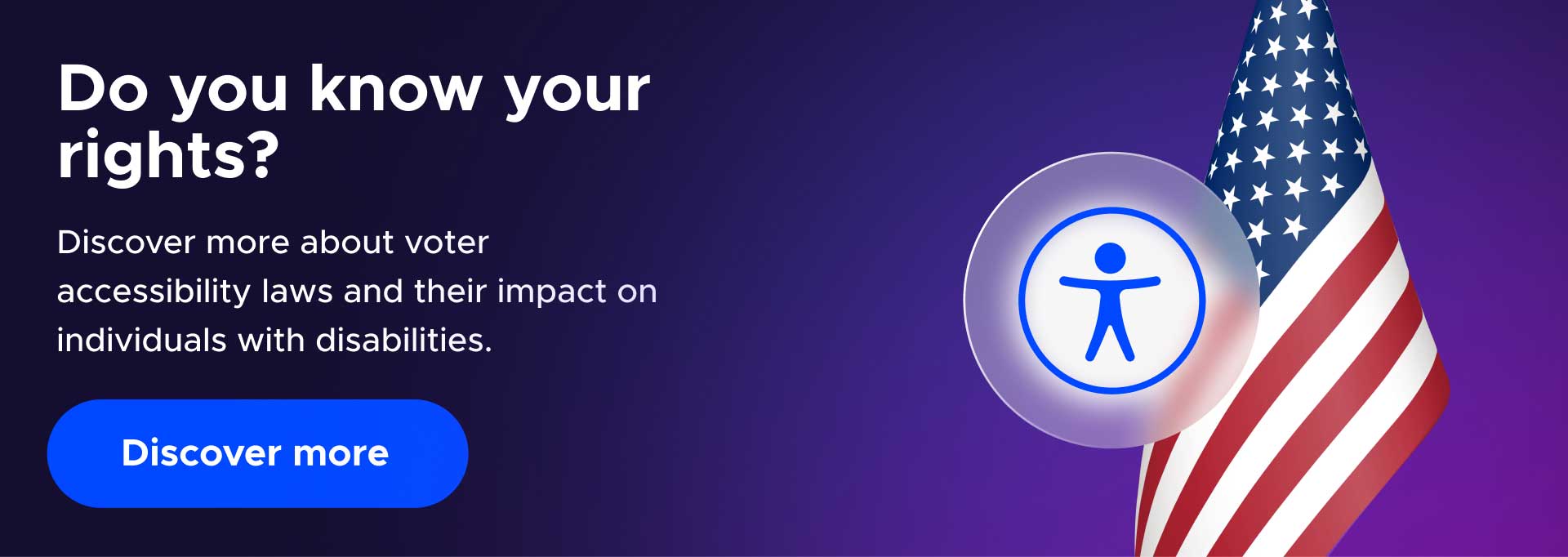Voters with disabilities: accessing the universal right to vote

Voting is a basic right that keeps our democracy ticking, giving everyone a say in how things are run. But for voters with disabilities, casting a vote can feel like navigating an obstacle course. And yet, of all our fundamental rights as American citizens, none is more critical than the right to vote. As the cornerstone of our democracy for over 200 years, it reflects the people’s will and empowers them to shape public policy.
So, what are the main hurdles for voters with disabilities? One significant barrier is inaccessible polling places. These physical spaces can deter voting when they’re not equipped with ramps, wide doorways, or appropriate signage. Additionally, complex voting systems with hard-to-navigate interfaces or small print ballots can exclude those with visual or cognitive impairments.
Making voting accessible can only happen when issues such as making voting booths accessible, providing voting assistance for disabled people and identifying ways to bring accessibility into polling places are addressed.
This blog explores voter accessibility laws, how they impact U.S. elections, and how they affect people with disabilities. We start with a deeper dive into voter accessibility laws.
What are accessibility laws in voting?
Disability and voting laws must ensure that every individual has equal access to the voting process, removing barriers and providing necessary accommodations. There are several laws establishing standards to boost accessibility for people with disabilities, including:
Americans with Disabilities Act (ADA)
The ADA ensures that polling places are physically accessible to individuals with disabilities. This includes having ramps, wide doors, and accessible parking. The ADA also mandates that voting machines be accessible to voters with disabilities, offering features like audio ballots and tactile interfaces.
Help America Vote Act (HAVA)
HAVA requires that each polling place have at least one accessible voting system for individuals with disabilities. These systems must allow voters to cast their ballots independently and privately. HAVA also provides federal funds to states to improve the accessibility of voting systems and polling places.
Voting Accessibility for the Elderly and Handicapped Act (VAEHA)
This act mandates that polling places across the United States be accessible to individuals with disabilities and the elderly. It also provides for alternative voting methods if the polling place is not accessible.
National Voter Registration Act (NVRA)
The NVRA requires states to offer voter registration opportunities at various public facilities, including disability services offices, to ensure that individuals with disabilities have ample opportunities to register to vote.
The Rehabilitation Act of 1973 (Section 504)
Section 504 ensures that programs and activities, including voting, that receive federal funding cannot discriminate based on disability. This law guarantees that people with disabilities have equal access to voting and registration processes.
But despite the legislative progress, physical access to the polls still needs to be improved. And without equal access to voting, many voters with disabilities get discouraged and skip the process altogether. In short, accessibility in U.S. elections fails to match the laws supporting it.
Over 61 million people in America have disabilities, potentially the country’s largest voting population. Even a relatively small cross-section of this group could alter the results of a primary election, which is precisely how a democracy should work. As the largest minority group globally, these citizens should be included in influencing laws through voting.
Although significant efforts have been made towards making voting more inclusive, many people with disabilities still encounter considerable barriers when attempting to exercise their right to vote. This calls into question the effectiveness of current policies and the extent to which policymakers are committed to ensuring an obstacle-free voting experience for everyone.
So, what opportunities are available to help people with disabilities vote?
How to vote with a disability
So how do you register to vote with a disability?There are voting accommodations for people with disabilities, providing opportunities to ensure they can participate in elections with independence. Here’s a breakdown of the different voting methods available:
- Mail-in ballots and absentee voting: For those who may find it challenging to vote in person, there are features that support ballot accessibility for disabled voters such as mail-in ballots and absentee voting for disabled voters being two convenient alternatives:
- Absentee voting: Absentee voting for disabled voters is another method. Typically used by those who cannot physically be present at the polling place on election day. Voters can request an absentee ballot, fill it out at their convenience, and mail it back.
- Curbside voting: Available in some locations, this lets voters cast their ballots from their vehicle, minimizing the need to manage accessibility issues inside polling stations.
- Accessible voting machines: Transportation and physical accommodation to polling places for disabled people is important. Ramps, wide doorways, and accessible parking spots close to the entrance. Inside, there should be enough space for wheelchairs and other mobility devices.
- Voting assistance: Many jurisdictions allow voters with disabilities to bring someone to help them at the polls or request assistance from election workers.
- Extended early voting: This gives voters with disabilities more flexibility to choose a time with fewer crowds and potentially fewer logistical challenges.
What are online voting options for disabled people?
In some jurisdictions, online voting options are available and can be particularly helpful for voters with certain disabilities:
- Online ballots: These can be accessed via a computer or smartphone, offering a user-friendly interface that can be adapted to the needs of voters with visual, motor, or cognitive impairments.
- Assistive technologies: Online platforms often support screen readers and other assistive technologies to facilitate the voting process for those with disabilities.
- Reporting issues: If any accessibility issues arise during voting, it’s important to report these problems to the appropriate authorities, such as the ADA or local election officials, to ensure they are addressed and improved for future elections.
These voting methods help ensure that all citizens, regardless of their physical abilities, can exercise their right to vote independently and securely. For more detailed information, you can visit the Election Assistance Commission.
What are the best practices for accessible voting?
Ensuring that voting is accessible to all citizens is a fundamental aspect of a healthy democracy. Accessible voting practices are not only a legal requirement but also a moral imperative that upholds the principles of equality and inclusivity. By implementing best practices for accessible voting, we can break down barriers and empower every voter, regardless of their physical or cognitive abilities, to participate fully in the electoral process.
Let’s run through the most effective strategies to achieve truly inclusive voting, from physical accessibility at polling stations to the integration of advanced technology in voting systems:
1. All polling must occur in physically accessible venues, with barrier-free access to facilities, parking, and public transportation.
2. Ensure accessible voting machines are accompanied by staff members who know how they work.
3. Ensure barrier-free voting by mail through online sites with an e-ballot return.
4. Inform voters with disabilities of all voting options available to them.
5. Candidates must have accessible websites and materials, so all voters know their policies and can make an informed decision when they vote.
The organizations supporting disabled voters
When it comes to supporting disabled voters, a few standout organizations are making a big difference. For example, the American Association of People with Disabilities (AAPD) runs initiatives that boost electoral participation through voter education and accessibility advocacy.
There’s also the National Disability Rights Network, which has a toolkit right on their website to help voters understand their rights and how to report violations. Lastly, don’t forget about local groups – they often work under the radar but make a huge impact by ensuring accessible polling places and offering transportation to polling places for disabled people on Election Day.
My Vote My Voice is an organization committed to enhancing democratic participation among people with learning disabilities and autism in the UK. They provide accessible resources, conduct surveys, and run awareness campaigns. Their work includes collaboration with social care providers and advocacy groups to ensure that everyone can exercise their voting rights.
Organizations that support disabled voters are vital because they help towards the effort to help everyone, regardless of their abilities, to participate in democracy. They help break down barriers that might prevent people with disabilities from voting, such as inaccessible polling stations or complex voting procedures. By providing resources, support, and education tailored to the needs of disabled individuals, these organizations empower a significant part of the population to exercise their rights and have a say in their government.
UserWay: Putting accessibility at the heart of voting
Voting is a universal right. If voting isn’t accessible to everyone, we can’t truly call it a democracy. Every voter should have the right to vote independently which is where UserWay plays a huge role. Dedicated to making the digital world accessible for everyone, UserWay’s suite of accessibility solutions helps organizations, including government agencies and election boards, to meet and exceed accessibility standards. By implementing UserWay’s tools, election websites and online voting platforms can start to become more user-friendly for people with disabilities, ensuring that information about voting rights and procedures is available to all. Discover more about digital accessibility today.
FAQs
What are the voting rights for people with disabilities?
People with disabilities have the right to accessible voting options and assistance at polling places to ensure they can vote independently and privately.
What are the voter ID requirements for disabled individuals?
Voter ID requirements for disabled individuals are generally the same as for other voters, but states may offer accommodations or alternatives if presenting an ID is difficult.
How can I advocate for disabled voters?
To advocate for disabled voters, you can support accessibility initiatives, work with advocacy groups, and engage in public awareness campaigns to promote inclusive voting practices.
What are some voting accessibility initiatives?
Voting accessibility initiatives include implementing accessible voting machines, offering mail-in ballots, and ensuring polling places are physically accessible to all voters.





Share